Key Takeaways
- Harmony is Key: Coordinating your shoes and handbag goes beyond color. Focus on texture, shape, and style synergy.
- Mix and Match: Neutral tones offer versatility, while bold colors and prints can be used as striking accents.
- Practicality Matters: Consider the occasion, comfort level, and function of your accessories to ensure a cohesive and convenient ensemble.
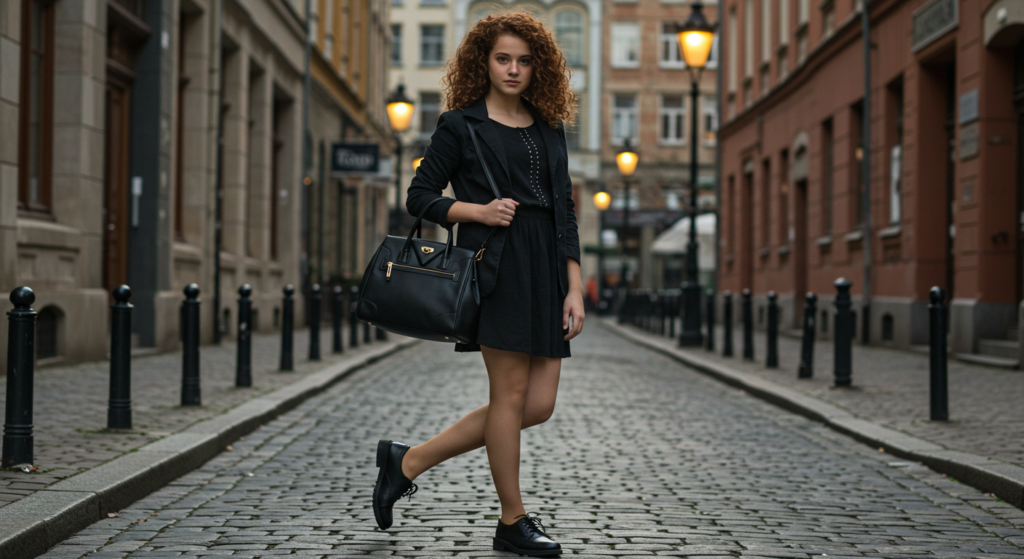
Matching shoes and handbags is an art that can elevate your outfit from ordinary to extraordinary. Yet, it’s not just about finding an identical color swatch.
The best ensembles leverage contrasting shades, complementary textures, and a keen sense of style to create a unified look. From discovering the perfect pairing for a business-casual setting to experimenting with playful combinations for a night out, your approach to shoes and bags can speak volumes about your personal style.
This comprehensive guide provides you with insider tips, creative techniques, and actionable strategies. You’ll learn how to strike the perfect balance between color and composition, ensuring your footwear and handbag always complement your attire.
Let’s dive into 14 in-depth sections—each featuring practical subsections—designed to elevate your fashion game.
Mastering Basic Color Coordination

Whether you’re new to the fashion scene or you’ve been curating your closet for years, understanding color coordination is a great starting point. Basic pairings help you form the backbone of your wardrobe, letting you mix and match with ease.
Neutral Foundations
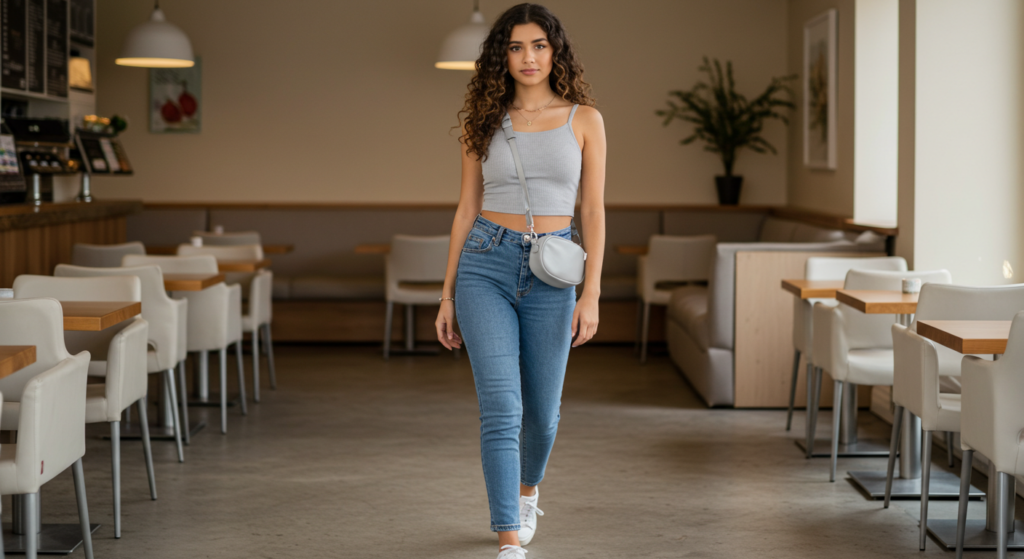
Definition & Examples:
A neutral color palette typically includes shades like black, white, gray, beige, and sometimes navy or brown. These tones act as a blank canvas, offering maximum flexibility for pairing with bold colors, patterns, or metallics.
Why It Works:
- Neutrals are versatile and reliable.
- They allow you to play with different accessories without overwhelming your outfit.
- Ideal for minimalist or professional settings.
Practical Tip:
Use one neutral tone (e.g., black shoes) and match it with a different neutral tone in your bag (e.g., beige). This subtle contrast is eye-catching but not overpowering.
Complementary vs. Contrasting

Complementary Pairing:
This approach pairs hues that sit opposite on the color wheel—like olive green shoes with a rust-colored bag. Though we’re skipping deep color psychology, the result is a visually striking ensemble.
Contrasting Pairing:
A more dramatic option: black shoes with a bright red bag. This method relies on bold differences that instantly draw attention. Keep the rest of your outfit relatively simple to let the accessories shine.
Practical Tip:
If you’re uncertain about trying two clashing colors, anchor your outfit with a neutral top or bottom. That ensures your accessories remain the focal point.
Simplifying with a Capsule Wardrobe

What Is a Capsule Wardrobe?
A capsule wardrobe is a curated collection of garments and accessories that mix and match effortlessly. In this setup, each piece complements the others, saving you time and energy.
Why It’s Useful:
- Minimizes clutter and confusion.
- Ensures consistency in color schemes and styles.
- Offers a solid foundation to build upon with trendier or seasonal items.
Practical Tip:
Pick 2-3 versatile shoe colors (black, beige, and maybe a metallic) and pair them with handbags in similar or complementary tones. Rotate them seasonally to keep your looks fresh.
Textures and Finishes Matter
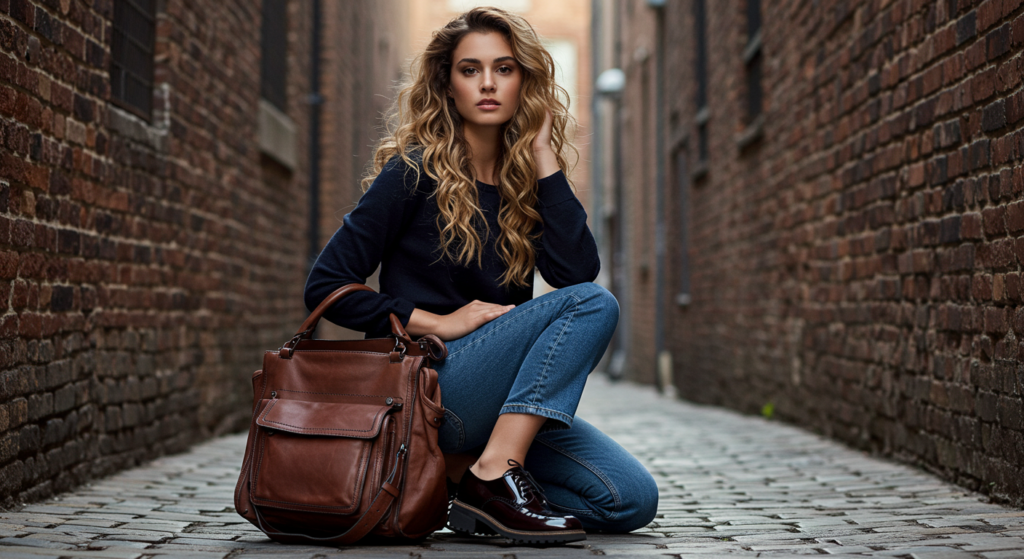
When coordinating your shoes and handbag, color is often the first thing people notice. But texture, finish, and materials can be equally important. Mixing or matching textures can create an interesting dynamic.
Playing with Textiles
Popular Textiles & Materials:
- Leather: Classic, durable, and sophisticated.
- Canvas: Casual, easygoing, and perfect for day-to-day.
- Suede: Soft texture, adds warmth, and an elevated vibe.
Why Texture Counts:
Even if you’re using the same color family, varying textures can break up monotony and add depth. For instance, pair glossy leather heels with a distressed leather bag for a subtle contrast.
Practical Tip:
Opt for a smooth leather bag if your shoes have an intricate texture, like snakeskin embossing. This prevents your overall look from appearing too busy.
Matte vs. Glossy
Matte Finish:
- More casual and understated.
- Subtle, absorbs light.
- Great for everyday or business-casual looks.
Glossy Finish:
- Shiny and attention-grabbing.
- Reflects light, adding a pop to your ensemble.
- Ideal for evening or special events.
Practical Tip:
You don’t have to match the finish exactly, but ensure that the contrast makes sense. If your shoes are extremely glossy, consider a bag that has at least a hint of shine or hardware detailing to tie the look together.
Layering Textures for Depth
Layering Concept:
Using a single accessory to add texture is great. But layering different textures in one outfit can create a more sophisticated style. For example, a velvet clutch paired with patent leather loafers can be a unique combo that stands out.
When It’s Best Used:
- Monochrome outfits that need a splash of depth.
- Transitional seasons like fall and spring.
- Anytime you want to subtly showcase your fashion knowledge.
Practical Tip:
Experiment with subtle texture contrasts at first. Try suede pumps and a smooth suede bag in similar shades. Once you’re comfortable, move on to bolder combos, like crocodile-embossed shoes with a plush quilted handbag.
Versatility for Different Occasions

Not all shoe-bag pairings are made for every event. Knowing when to opt for a sleek black stiletto with a matching clutch—and when to rock a bold sneaker with a crossbody—keeps your style both appropriate and exciting.
Dressing for Work
Why Accessory Choices Matter at Work:
- Contributes to a polished, professional appearance.
- Reflects your attention to detail and organizational skills.
Ideal Combinations:
- Subtle Leather Pumps with a structured top-handle bag: Clean, refined, and versatile.
- Low-Heeled Ankle Boots with a tote bag: Comfortable yet professional for cooler months.
Practical Tip:
Stick to neutral or muted tones for shoes and bags. This approach lets you experiment with bolder clothing items—like a patterned blouse—without looking unprofessional.
Weekend Casual
Defining Weekend Casual:
Laid-back, comfortable, and expressive. Think about errands, brunch, or casual gatherings with friends.
Recommended Pairings:
- Sneakers and a crossbody bag: Perfect for on-the-go.
- Flat Sandals and a woven tote: Ideal for summer vibes.
Practical Tip:
Don’t be afraid to play with brighter colors or patterns in a casual setting. If your sneakers are color-blocked, you can choose a bag in a single pop color drawn from the shoes.
Evening and Special Events
Key Elements:
- Touches of luxury (metallic details, embellishments).
- Elevated finishes (patent leather, satin, or velvet).
- More compact bag styles (clutch, wristlet).
Go-To Combinations:
- Strappy Heels with a metallic clutch for formal dinners.
- Embellished Flats with a small chain bag for a stylish but comfortable event look.
Practical Tip:
Allow a single focal point if you’re going for shine or embellishments. For instance, if your shoes are heavily detailed, choose a more subdued handbag.
Seasonal Shifts

Colors and materials naturally shift with the seasons. Matching your shoes and handbag accordingly keeps you looking on-trend and well-prepared for weather changes.
Spring Flair
Color Focus:
Soft pastels (lavender, mint, pale pink), or gentle neutrals that align with the cheerful mood of spring.
Recommended Textiles:
- Light Leather or Canvas: Breathable, suits mild temperatures.
- Suede in pastel shades: Ideal for crisp spring days.
Practical Tip:
Don’t shy away from floral prints on your bag or shoes. Pair subtle florals on your handbag with solid-colored shoes to create a balanced look.
Summer Brights
Color Focus:
Vibrant hues (yellow, coral, turquoise) and lighter neutrals like white or off-white.
Bag Types:
- Wicker Bags or straw totes for a breezy, beachy feel.
- Crossbody Bags in bright shades for festivals or outdoor concerts.
Practical Tip:
White shoes can be your best friend in summer. A matching or coordinating handbag in off-white or a bright pop color creates a cool, refreshing vibe.
Fall and Winter Classics
Color Focus:
Deep, rich tones (burgundy, forest green, navy, chocolate brown) and textured neutrals.
Suggested Materials:
- Suede and leather dominate in colder months.
- Patent leather can offer an eye-catching accent during dull winter days.
Practical Tip:
Coordinate your footwear and handbag with seasonal outerwear like coats or scarves. This unifies your entire ensemble and keeps you looking polished even in colder conditions.
Statement Pieces and Accents
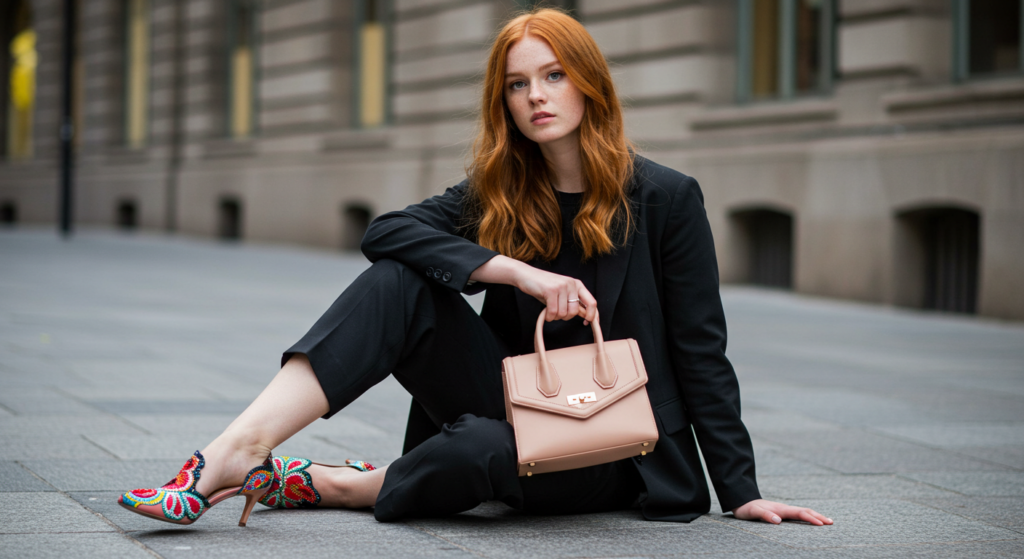
Sometimes your shoes or your bag will demand the spotlight. If you have a bold statement piece, let it shine by styling the rest of the outfit around it.
Bold Shoes
Types of Bold Shoes:
- Bright pumps
- Patterned boots
- Embellished sneakers
Styling Approach:
- Keep your bag simpler in color and style.
- Use subtle patterns that pick up an accent color from the shoes.
Practical Tip:
If your footwear screams for attention, ensure your handbag echoes a single color or material hint from the shoes. That way, you appear coordinated rather than clashing.
Statement Bags
Defining Statement Bags:
These can be covered in beads, sequins, prints, or even fringes—anything that grabs attention.
Styling Approach:
- Pair with shoes in neutral or solid shades.
- Allow the bag to be the star by avoiding competing patterns.
Practical Tip:
Make sure your overall outfit color palette complements the bag. If the bag is a metallic gold statement piece, black or deep navy shoes can keep the look chic.
Finding Balance
Why Balance Matters:
Too many standout elements can overwhelm the eye. Instead, think of your shoes and handbag as a team. When one is loud, the other can be quieter.
Practical Tip:
Use a color swatch from the statement accessory to match or complement the secondary accessory. This technique ties the entire outfit together without overdoing it.
Matching Prints and Patterns
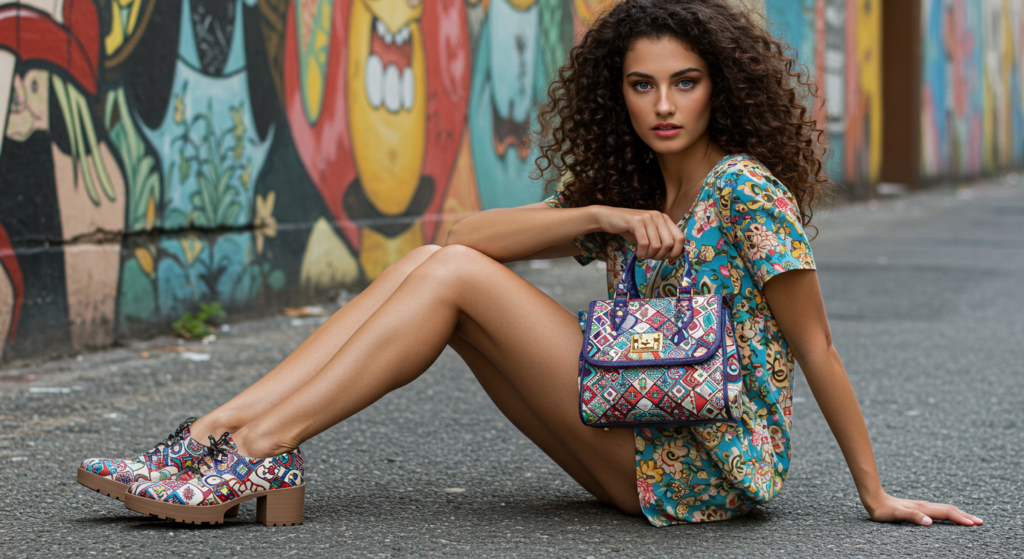
Prints and patterns can be an excellent way to showcase your creativity, but they also pose a risk of clashing. Strategic choices help you navigate this territory successfully.
Coordinating Colors within Prints
What to Look For:
Most prints have multiple colors in their design. Pick one dominant color from the pattern to match your other accessory.
Example:
If your shoes have a floral design with hints of blush pink, sage green, and off-white, choose a bag in a blush pink or sage green. This instantly pulls the look together.
Practical Tip:
When in doubt, match your print with a neutral bag or shoe. Neutral accessories serve as a safe backdrop for any bold pattern.
Mixing Patterns the Right Way
Advanced Styling Move:
Mixing stripes with florals or polka dots with geometric shapes can work if you maintain a unifying factor—often color.
How to Do It:
- Choose a similar color palette across both patterns.
- Keep at least one accessory or garment solid to anchor the look.
Practical Tip:
If you’re mixing multiple patterns in your outfit, opt for simpler footwear. A bold printed blouse plus a printed handbag might be enough pattern for one look. Keep your shoes neutral or in a subtle color picked from the pattern.
When to Dial It Back
Signs of Overkill:
- You feel overwhelmed by too many visual elements.
- The patterns clash rather than complement each other.
How to Fix It:
- Remove one patterned item and replace it with a solid color.
- Or look for a pattern with smaller prints that can act as a textural element instead of a full-blown statement.
Practical Tip:
Use a mirroring technique: if your bag has large, bold patterns, choose shoes with smaller, more subtle patterns in a related color scheme, or vice versa.
Size and Proportion
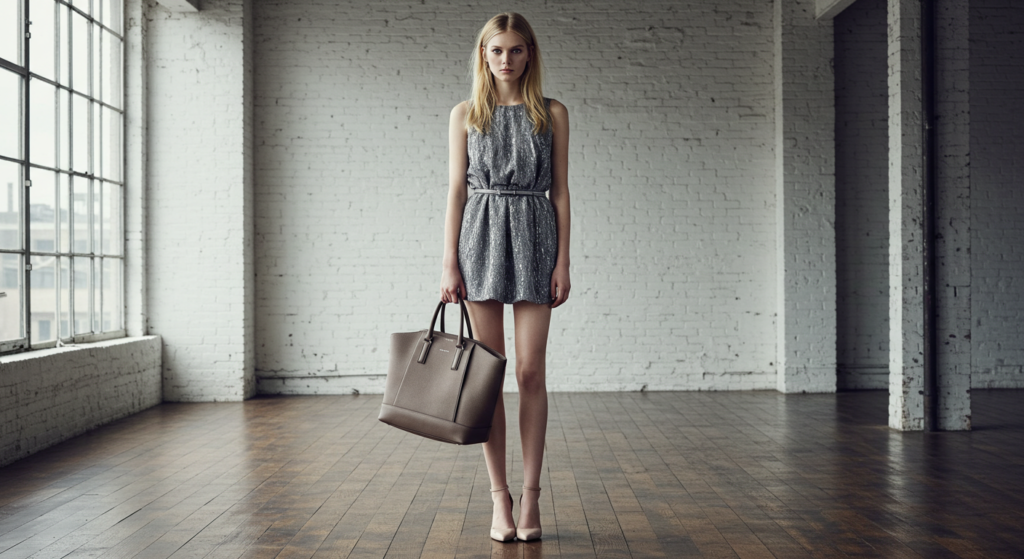
While color and style are crucial, ignoring proportion can ruin an otherwise well-matched ensemble. Consider the scale of your bag relative to your footwear and your overall body type.
Balancing Large Handbags
Common Mistake:
Carrying an overly large tote with delicate, strappy sandals can create a visual imbalance.
How to Balance:
- Pair chunkier shoes (block heels, sturdy boots) with bigger bags.
- Wear slimmer footwear (flats, pointed pumps) with medium to smaller bags.
Practical Tip:
If you love oversized bags, aim for shoes with a bit of presence—like a wedge sandal or a platform sneaker—to keep your overall look cohesive.
Small Bags and Sleek Footwear
Why It Works:
A compact crossbody or clutch naturally pairs well with more delicate footwear, such as pointed flats, kitten heels, or dressy sandals.
How to Pull It Off:
- Ensure the bag strap length complements your silhouette.
- Go for shoes that visually align with the minimal look of a smaller bag.
Practical Tip:
When attending formal events where small handbags are common, avoid bulky footwear. Instead, choose sleek shoes that match the event’s elegance.
Proportion Tips for All Body Types
Universal Guidelines:
- Keep the scale of your bag in line with your body proportions.
- Choose shoes that also flatter your frame.
Practical Tip:
Try standing in front of a full-length mirror to judge if your handbag and shoes look balanced. If something feels off, either switch to a smaller or larger bag or choose a different shoe style.
Accessorizing Beyond Color
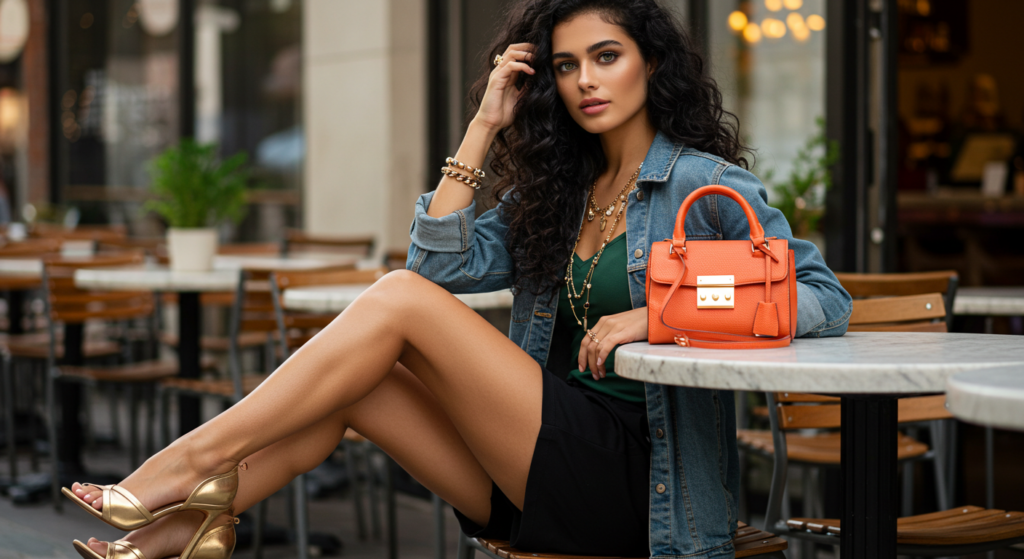
Jewelry, belts, and even scarves can tie your entire outfit together. Sometimes these additional accessories bridge the gap between your shoes and bag in unexpectedly stylish ways.
Using Metallic Elements
Metallic Accents:
Hardware on handbags (buckles, chains) or on shoes (toe caps, studs) can act as a unifying theme.
How to Coordinate:
- Match metal tones (silver with silver, gold with gold).
- Don’t overdo multiple metal finishes in one outfit.
Practical Tip:
A small detail like gold-toned buckles on your handbag can sync perfectly with gold metallic stripes on your shoes.
Belts as a Unifying Accessory
Why Belts Matter:
A belt can serve as a bridge between your top and bottom half, tying your shoes and handbag into a cohesive look.
How to Use:
- Match the belt color or texture with your shoes or bag.
- Go for a bold belt if both shoes and bag are neutral, or vice versa.
Practical Tip:
If you have a patterned shoe, a belt in one color from that pattern can help unify the outfit. Then choose a handbag that aligns with the belt color or style.
Scarves and Other Add-Ons
Additional Accents:
Scarves, hats, or even a stylish headband can incorporate the color scheme of your accessories.
Why It Works:
Adding a patterned scarf with bits of your shoe or bag color can be the finishing touch that ties everything together.
Practical Tip:
If you wear a scarf, drape it so that its color is visible near the bag or footwear line. This visual repetition amplifies the sense of coordination.
Tailoring Your Look to Different Settings
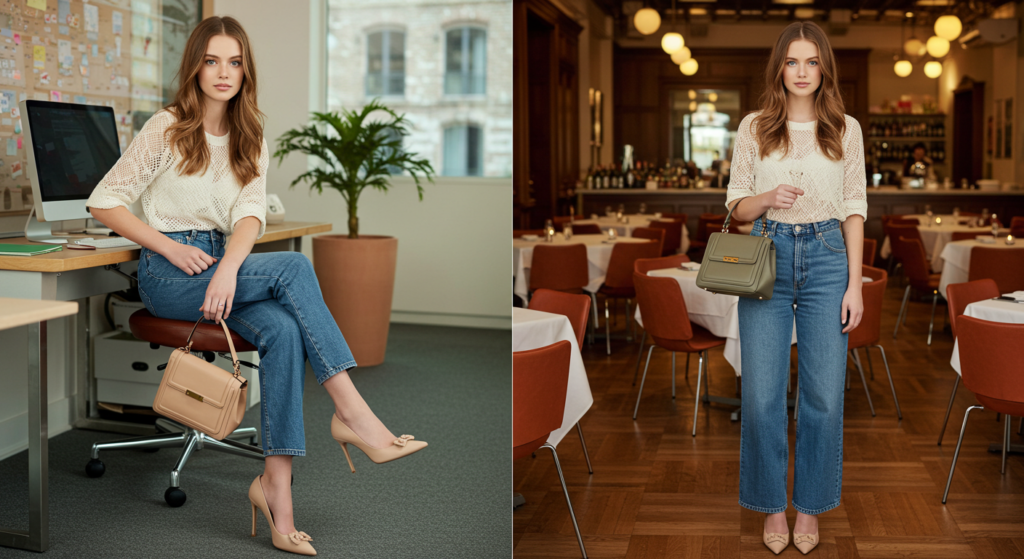
Fashion is not one-size-fits-all. Different settings—such as creative workplaces, formal dinners, or traveling—require specific shoe and bag strategies to fit seamlessly.
Creative Work Environments
Allowed Flexibility:
In a creative office, you can experiment with bold colors, playful textures, and unique silhouettes.
Ideas to Try:
- Chunky heels with a statement satchel.
- Printed loafers with a suede or velvet tote.
Practical Tip:
Add a cohesive element, like matching a color from the shoes to the bag’s piping or handle. This subtle detail ties the look together without compromising creativity.
Formal Dinner or Events
Style Criteria:
Elegance, refinement, and attention to detail matter. Typically, smaller bags (clutches, minaudières) are the go-to.
Ideal Combinations:
- Classic black pumps with a sequined clutch for black-tie.
- Nude heels with a metallic envelope bag for a sophisticated yet understated vibe.
Practical Tip:
Focus on finish and embellishments. If your shoes have minimal decoration, your bag can have a bit more sparkle. But avoid mixing too many glitzy elements in a single outfit.
Travel and Comfort
Why It’s Important:
Airports, long drives, and exploring new cities call for practical footwear and a convenient bag, yet you can still be stylish.
Recommended Pieces:
- Sneakers or comfortable flats with a crossbody or backpack.
- Slip-on mules with a roomy tote for quick-access items.
Practical Tip:
Match your travel bag’s color or style to your shoes for an effortlessly put-together look—even if you’re running through an airport or strolling around a foreign city.
Closet Organization for Easy Pairing

A well-organized closet is your secret weapon. It helps you see potential pairings more clearly and saves time when you’re rushing out the door.
Grouping by Color
Method:
Arrange shoes and bags by color or color family: neutrals in one section, brights in another, and so on.
Benefits:
- Speeds up decision-making.
- Reveals gaps in your collection (e.g., missing a bold red bag).
Practical Tip:
Within each color group, you can further organize by type or season. For instance, keep summer sandals near your bright crossbodies, and place winter boots near your darker totes.
Using Storage Solutions
Ideas for Efficient Storage:
- Clear plastic boxes for shoes.
- Shelf dividers for bags.
- Hanging organizers for clutches.
Practical Tip:
Label boxes or shelves with color or style names. This small detail makes it easier to locate your desired pair of shoes or that matching bag.
Rotating Seasonal Items
Why It Helps:
Keeping out-of-season items in the front of your closet can cause confusion. Rotating them ensures you stay on top of relevant styles for the current weather.
Practical Tip:
Pack off-season shoes and bags in clearly labeled boxes, then store them away. Bring them back out when the season changes. This also keeps your collection fresh, helping you re-discover items you might have forgotten.
Spotting Trends and Incorporating Them
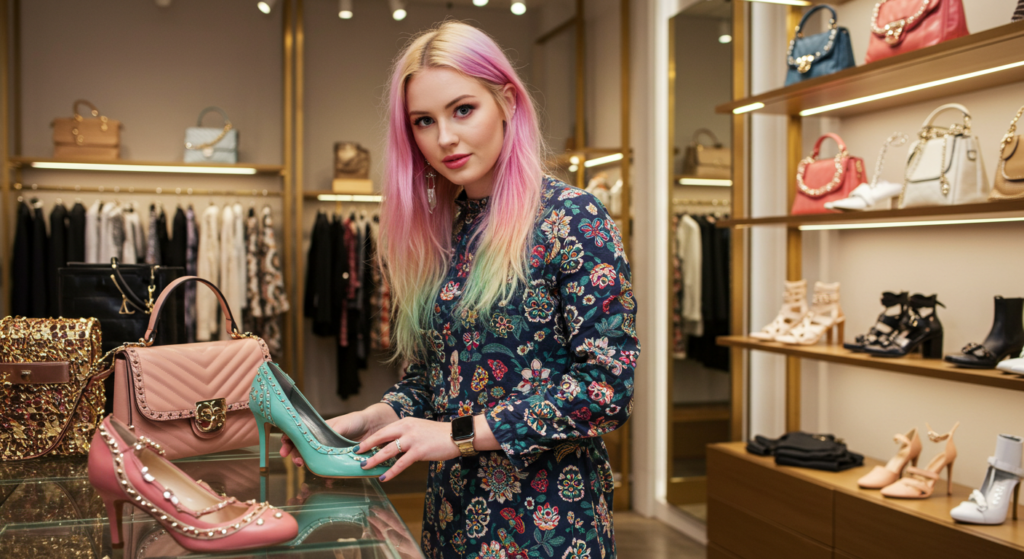
Fashion evolves, and new color trends or accessory styles appear each season. Knowing how to interpret these trends without sacrificing personal style is key.
Trend Research
Where to Look:
- Fashion magazines and websites
- Runway recaps
- Street style photos
Practical Tip:
Pick trends that fit your existing wardrobe. If neon is trending, maybe start with a neon handbag before going full neon with your shoes.
Adapting Trends to Personal Style
Best Practices:
- Choose one trend-focused accessory to elevate a classic outfit.
- If the trend is bold, keep the rest of your look more timeless.
Practical Tip:
Trends fade, but style endures. Invest in a trendy bag if you love it, but don’t break your budget. Also, test a trend with less expensive accessories before committing to higher-end pieces.
Avoiding Trend Overload
Common Pitfall:
Wearing multiple high-trend pieces simultaneously can appear disorganized.
How to Avoid:
- Limit yourself to one or two trends per outfit.
- Keep your color palette consistent, even if the pieces are on-trend.
Practical Tip:
Look at your outfit in daylight or a well-lit mirror. If a single item seems out of place or the ensemble looks too chaotic, swap or remove one trend piece.
Sustainable and Ethical Choices

Though we’re not diving into deep social discourse, making mindful choices about your footwear and handbags can be part of a well-rounded fashion approach.
Considering Quality Over Quantity
Why It Matters:
Long-lasting items reduce waste and often look better over time. High-quality leather or responsibly sourced materials help ensure your wardrobe stands the test of time.
Practical Tip:
Invest in timeless shoe and bag colors—like black, brown, or navy—so you can use them for years without worrying about trends.
Eco-Friendly Materials
Options:
- Vegan Leather (various plant-based or synthetic alternatives).
- Recycled Materials in handbags or shoe soles.
Practical Tip:
Check care instructions. Some eco-friendly materials may need gentler handling, but it’s worth it to keep them looking their best.
Maintaining Your Pieces
Importance:
Extending the life of your items is the most sustainable move you can make.
Practical Tip:
Use appropriate protective sprays, store your bags in dust bags, and regularly clean and condition your shoes. This helps them remain in top shape season after season.
Confidence and Personal Expression

Ultimately, matching your shoes and handbag is about feeling great in what you wear. It’s a form of self-expression that allows you to play with trends, shapes, and colors while staying true to yourself.
Embracing Your Personal Taste
Why Individuality Counts:
Fashion rules can guide you, but your style is uniquely yours. If something speaks to you, there’s usually a way to make it work.
Practical Tip:
Collect inspiration from fashion blogs or social media, but always adapt the look to suit your preference and comfort level.
Trying New Combinations
How to Experiment:
- Go through your closet and create combos you’ve never tried.
- Take photos to compare looks and get feedback from friends.
Practical Tip:
Set aside a weekend to play dress-up. Mix that bold bag you rarely use with different pairs of shoes. You might discover a fresh favorite outfit.
Building a Signature Style
What Is a Signature Style?
It’s the recognizable “you” in every outfit. Maybe it’s your love for bright bags or your preference for sleek, neutral shoes.
Practical Tip:
If you find yourself repeatedly drawn to a particular color or accessory, build your wardrobe around it. This continuity makes it easier to match shoes and bags effortlessly.
Dressing on a Budget
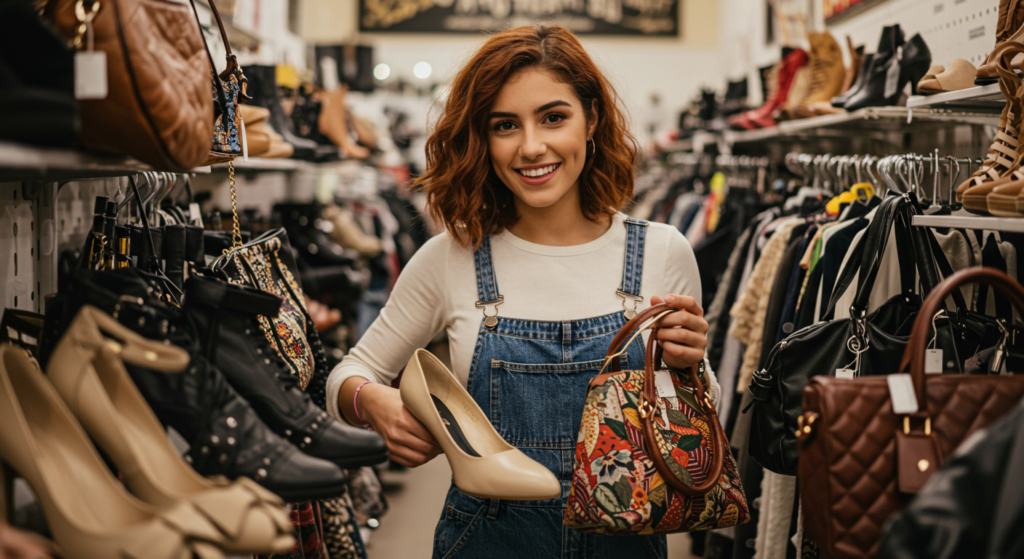
You don’t have to spend a fortune to look stylish. Budget-friendly options exist, and savvy shopping can help you secure timeless and on-trend pieces without emptying your wallet.
Thrift and Vintage Stores
Why They’re Great:
- Unique finds that stand out.
- Often more affordable than brand-new retail.
Practical Tip:
Inspect for wear and tear, especially zippers, buckles, and soles. If a piece looks easily repairable, consider investing in simple repairs for a one-of-a-kind accessory.
Off-Season Sales
Timing:
Retailers frequently discount seasonal items when a new season’s stock arrives. You can find top-quality shoes and bags at a fraction of the original price.
Practical Tip:
Buy winter boots or rich-toned handbags in late winter or early spring. Store them for the next cold season to get a head start.
Mindful Dupes
Definition:
Dupes are low-cost versions of popular, often high-end, designs. They’re not counterfeits but merely inspired pieces.
Practical Tip:
Look for good-quality dupes with solid construction. They can let you experiment with trendy shapes or colors without the designer price tag.
Final Tips and Pitfalls to Avoid
As you refine your matching game, keep in mind a few overarching strategies, and steer clear of common blunders that might derail an otherwise great look.
Common Mistakes
- Overcoordinating: Matching everything too perfectly can look dated or forced.
- Ignoring Occasion: Wearing glittery heels and a matching clutch to a casual barbecue can feel out of place.
- Forgetting Comfort: No matter how stylish the pairing, if you can’t walk comfortably, it’s a no-go.
Quick Wins
- Keep a “cheat sheet” of your favorite combos.
- Break in new shoes before pairing them with a special-occasion bag.
- Use mirror checks from different angles.
Evolving Your Style
- Stay open to new ideas and inspirations.
- Declutter periodically to make room for fresh looks.
- Embrace age-appropriate updates. (If a style no longer resonates, swap it for something that does.)
Conclusion
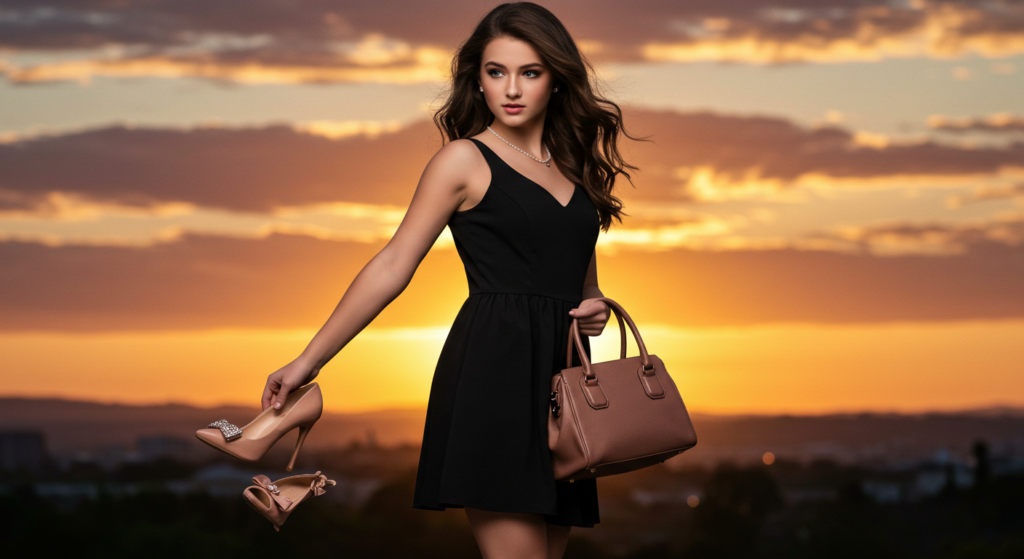
Matching your shoes and handbag is a rewarding endeavor, combining creativity, practicality, and personal flair. From mastering basic color coordination to experimenting with textures, patterns, and even exploring budget-friendly solutions, the possibilities are endless.
The art of matching isn’t just about looking polished—it’s about expressing who you are through your accessories. If you keep an open mind and trust your instincts, you’ll discover that finding the perfect shoe-and-bag combo can truly transform your wardrobe and your confidence.
Summary Table
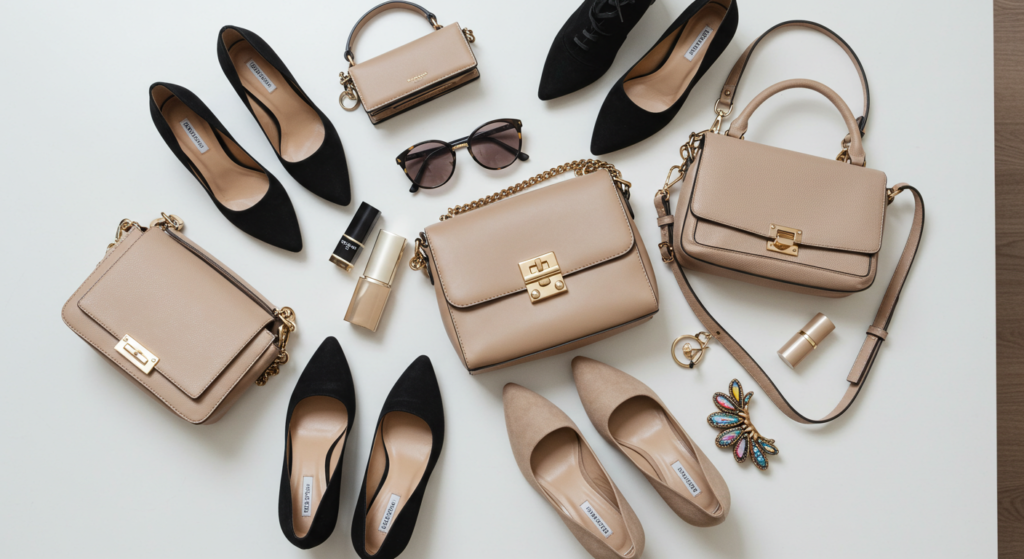
| Technique | Best Used For | Key Benefit |
|---|---|---|
| Neutral Foundations | Everyday, Work | Ensures versatility and an easy-to-match palette |
| Bold Contrast Pairings | Events, Statement Looks | Creates an eye-catching, memorable ensemble |
| Texture Layering | Elevated Casual, Seasonal Wear | Adds depth and visual interest to your outfit |
| Statement Pieces Balancing | Formal Events, Showcases | Focuses attention while maintaining cohesion |
| Capsule Wardrobe Approach | Minimalist Lifestyle | Saves time and money by focusing on key staples |
| Accessorizing with Metallic Elements | Formal Events, Polished Looks | Unifies accessories through hardware details |
| Budget-Friendly Shopping | Thrift, Off-Season Sales | Access to unique or trend items without overspend |
FAQ

How do I know if my shoes and bag clash?
Check if your accessories look harmonious when you stand in front of a mirror. If one piece overpowers the other in color, size, or style, they might be clashing. Consider unifying them by matching a detail like hardware color or choosing a shared accent shade.
Is it okay to mix different leather types?
Yes. Mixing smooth leather with suede or even embossed leather can add depth. Just ensure the colors or finishes don’t compete too much. Pick a single color family to tie the look together.
Do my shoes and bag need to have the same shade of neutral color?
Not necessarily. Slight variations in neutrals—like a dark gray bag with black shoes—can look polished and add subtle interest. The key is to make sure they complement the overall outfit.
Are patterned shoes harder to match with bags?
They can be, but focusing on one main color from the pattern simplifies the process. If your shoes feature multiple tones, pick one hue and use it for the handbag or another accessory, like a belt or scarf.
What if I want to wear very bright shoes?
Balance them out by choosing a more subdued or neutral handbag. If you’re feeling adventurous, pick a bag that features a small accent of the bright shoe color. That small detail can tie everything together without going overboard.
Can I match my shoes and bag with my outfit color exactly?
Exact matching can sometimes look dated. It’s usually more modern to create a slight variation—like contrasting textures or introducing a complementary color. But if you love the monochromatic look, go for it and balance the rest of your outfit with neutral or lighter shades.
With these insights and techniques, you’re well-equipped to create stylish and cohesive outfits for every occasion. Whether you choose to keep it neutral or experiment with bold, eye-catching pairings, remember: confidence is the best accessory you can wear. Happy matching!

Joanna Perez, with a degree in Creative Writing, excels in recommending distinctive clothing color mixes and trends that deeply connect with readers. She simplifies the often daunting task of color selection, making fashion decisions more personalized and impactful. Her passion for vibrant color palettes and the stories they tell makes her an indispensable voice in the fashion community.
Reviewed By: Marcella Raskin and Anna West
Edited By: Lenny Terra
Fact Checked By: Sam Goldman
Photos Taken or Curated By: Matthew Mansour
